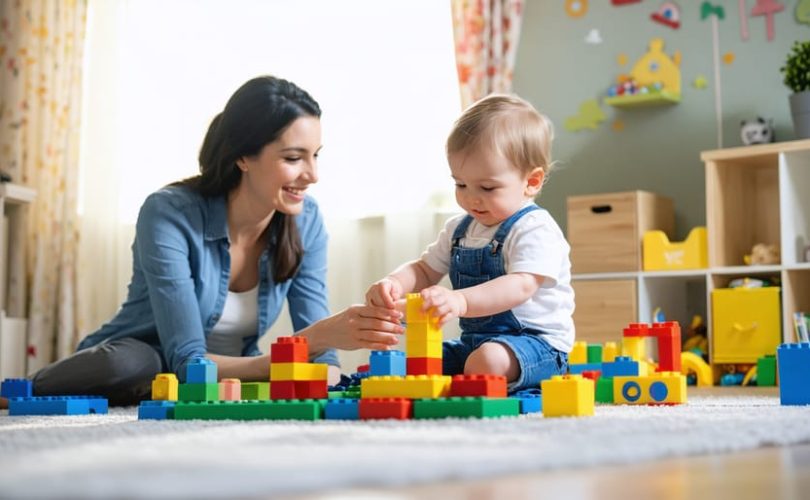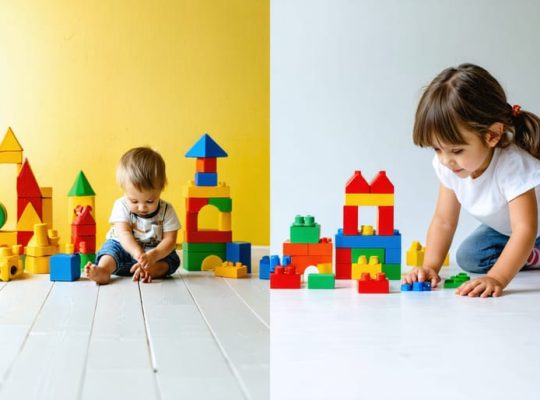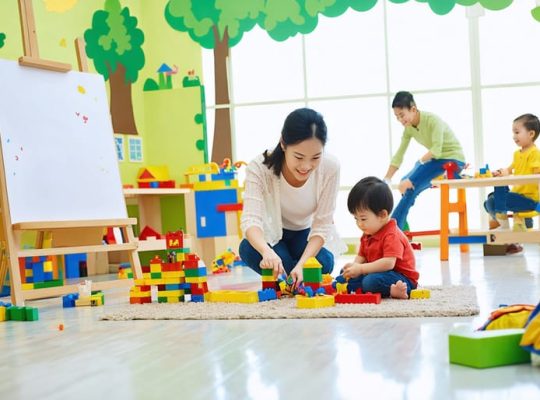Transform your child’s development through play-based learning approaches that create lasting emotional connections and foster crucial life skills. Recent research reveals that just 20 minutes of focused play can significantly reduce behavioral challenges while strengthening parent-child bonds.
Play-based interventions offer a natural, effective way to support children through developmental challenges, trauma, and everyday stress. Whether you’re a parent, teacher, or healthcare professional, these therapeutic techniques harness children’s innate language – play – to build resilience, improve communication, and promote emotional regulation.
Unlike traditional therapy methods, play-based interventions meet children where they are most comfortable, turning everyday moments into opportunities for growth and healing. Through carefully structured play activities, children learn to express complex emotions, develop problem-solving skills, and build stronger relationships with their caregivers.
This practical guide will equip you with evidence-based strategies to implement play-based interventions effectively, helping you create meaningful connections while supporting your child’s emotional and social development. From simple daily activities to more structured therapeutic approaches, you’ll discover how to transform playtime into powerful moments of healing and growth.
Why Play-Based Interventions Work
The Science of Play and Attachment
When children engage in play with their caregivers, something remarkable happens in their brains. Research shows that parent-child bonding through play triggers the release of oxytocin, often called the “bonding hormone,” which strengthens emotional connections and builds trust.
Studies by child development experts have found that playful interactions create safe spaces where children feel comfortable expressing their feelings and processing difficult emotions. During play, children’s stress levels decrease, making them more receptive to forming secure attachments with their caregivers.
Dr. Sarah Thompson, a child psychologist, explains: “When parents fully engage in play with their children, they’re not just having fun – they’re laying the foundation for emotional resilience and healthy relationships. The back-and-forth nature of play helps children develop empathy and social skills while feeling deeply understood and valued.”
This scientific understanding of play’s impact on attachment has revolutionized how we approach childhood emotional development, showing us that seemingly simple playful moments carry profound significance for lifelong emotional well-being.
Benefits for Both Parent and Child
Play-based interventions create a unique opportunity for mutual growth and connection between parent and child. When parents actively engage in therapeutic play, they often report feeling more attuned to their child’s emotional needs and better equipped to handle challenging behaviors. Children, in turn, show increased trust and openness with their parents, leading to stronger emotional bonds.
Parents frequently discover new aspects of their children’s personalities and gain valuable insights into their inner worlds through play. This deeper understanding helps them become more effective advocates for their children’s needs and more confident in their parenting decisions. Many parents also report reduced stress levels and increased joy in their parenting journey.
For children, having a parent fully present during play sessions creates a safe space for emotional expression and skill development. They typically show improvements in self-regulation, communication skills, and problem-solving abilities. The shared experience often leads to decreased anxiety, better behavior at home, and increased willingness to tackle challenging situations.
This collaborative approach also helps break negative interaction cycles, replacing them with positive, nurturing experiences that benefit both parent and child long after the play session ends.
Essential Play-Based Techniques
Child-Led Play Sessions
Following your child’s lead during playtime can transform ordinary play sessions into powerful bonding experiences. When engaging in child-directed play activities, let your little one take charge while you become their attentive playmate.
Start by sitting at your child’s level and waiting for them to initiate play. Notice what captures their interest and join them in their chosen activity without taking control. If they’re stacking blocks, resist the urge to show them the “right” way – instead, mirror their actions and express genuine interest in their creative choices.
Use encouraging phrases like “I see you’re building something interesting” or “Tell me more about your creation.” These responses validate their choices and boost their confidence. Remember to avoid asking too many questions or directing the play – your role is to be present and supportive.
Dr. Sarah Chen, a child psychologist, explains: “When children lead play sessions, they develop decision-making skills and feel more empowered in their relationship with their parents. This builds trust and strengthens emotional connections.”
If your child seems stuck, wait patiently before offering gentle suggestions. Sometimes, silence and your attentive presence are all they need to explore and express themselves freely. These moments of child-led play become treasured opportunities for connection and growth.
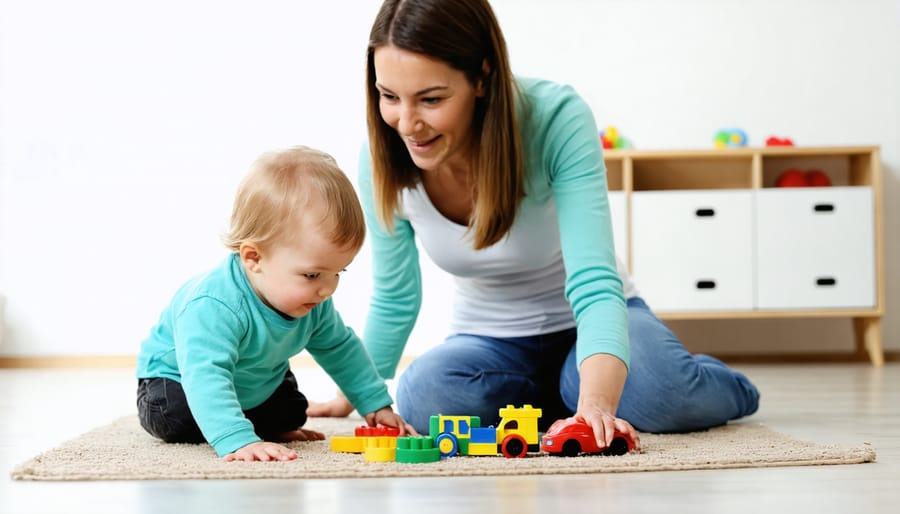
Therapeutic Role-Playing
Therapeutic role-playing provides children with a safe space to explore and process their emotions through pretend play. When children act out scenarios, they can work through challenging situations, express difficult feelings, and develop problem-solving skills in a non-threatening environment.
For example, a child struggling with separation anxiety might benefit from playing “school” with their stuffed animals, where they practice saying goodbye and reuniting. Through this process, they can master their fears while feeling in control of the situation.
Dr. Sarah Chen, a child psychologist, explains: “When children engage in therapeutic role-play, they’re actually rehearsing life skills and developing emotional resilience. It’s like a dress rehearsal for real-life situations.”
Parents and caregivers can facilitate therapeutic role-play by:
– Following the child’s lead in choosing scenarios
– Asking open-ended questions about the characters’ feelings
– Offering gentle suggestions to explore solutions
– Maintaining a supportive, non-judgmental presence
Role-playing can address various challenges, from dealing with bullying to adjusting to a new sibling. A child might use dolls to act out playground conflicts or pretend to be a doctor treating a worried patient before their own medical appointment.
Remember to keep the play child-directed while providing gentle guidance. This balance helps children feel empowered while processing their experiences in a healthy, constructive way.
Sensory Play Activities
Sensory play activities engage multiple senses, creating meaningful connections between children and their caregivers. When we incorporate touch and movement into playtime, we help children process their emotions while strengthening our bond with them.
Simple activities like finger painting can become powerful bonding experiences. Watch as your child explores different textures and colors, and join in their creative process. This shared experience often opens doors to communication and emotional expression that might otherwise remain closed.
Creating sensory bins filled with materials like rice, beans, or water beads offers endless opportunities for exploration. As you play alongside your child, narrate their discoveries and mirror their excitement. This validation helps them feel seen and understood.
Movement-based activities like dance parties or obstacle courses not only release physical energy but also promote emotional regulation. When children feel overwhelmed, these activities can help them return to a calmer state while maintaining connection with their caregiver.
For younger children, gentle activities like bubble-blowing or playing with soft fabrics can be particularly soothing. These quiet moments of shared attention create space for emotional attunement and security.
Remember to follow your child’s lead during sensory play. Some children may be sensitive to certain textures or movements, and that’s perfectly okay. The goal is to create a safe, enjoyable experience that strengthens your relationship through shared discovery and joy.

Creating a Safe Play Environment
Physical Space Setup
Creating a welcoming play space is essential for successful play-based interventions. Start by designating a specific area that’s safe, comfortable, and free from distractions. This could be a corner of a room or a dedicated playroom where structured play environments can be established.
Consider organizing toys and materials at child height, using clear containers or open shelving to make items easily accessible. Include soft elements like cushions or a small rug to create a cozy atmosphere where children feel secure. Ensure good lighting, either natural or warm artificial light, to maintain a cheerful environment.
Keep the space uncluttered but engaging, with distinct areas for different types of play. You might include a quiet corner for reading or calming activities, an open space for movement, and a table for arts and crafts. Remember to rotate toys periodically to maintain interest while avoiding overwhelming choices.
The key is to create a space that invites exploration while remaining organized and manageable. This balance helps children feel both stimulated and secure during play therapy sessions.
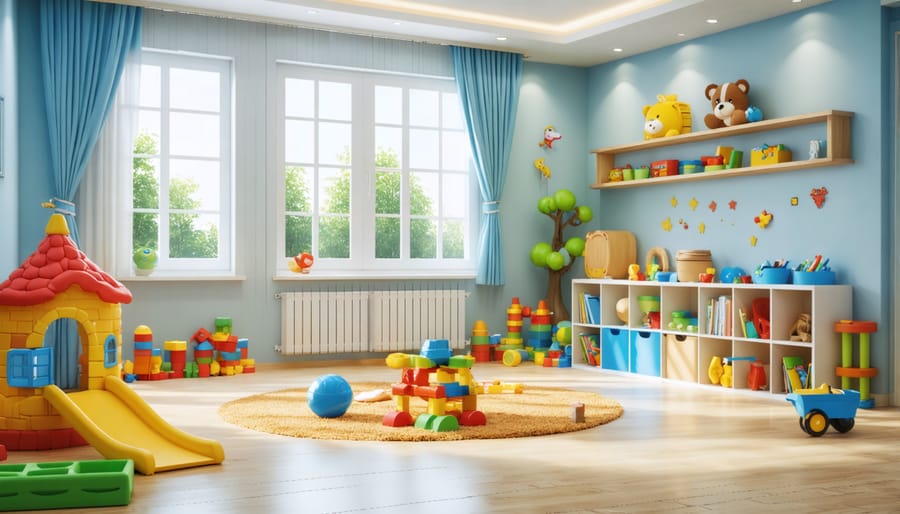
Emotional Safety Guidelines
Creating a safe emotional environment during play sessions is crucial for children to feel secure and express themselves freely. When children feel emotionally safe, they’re more likely to engage meaningfully in play activities and share their thoughts and feelings openly.
Start by establishing consistent routines and boundaries that help children know what to expect. Always validate their emotions and avoid dismissing their feelings, even if they seem trivial to adults. Phrases like “I see that made you upset” or “It’s okay to feel frustrated” help children feel understood and supported.
Be fully present during play sessions, maintaining eye contact and showing genuine interest in their activities. Avoid criticism or judgment of their play choices, and instead offer gentle encouragement and support. If a child becomes overwhelmed or distressed, provide a quiet space or “calm corner” where they can regulate their emotions.
Remember that some children may need more time to warm up to play activities. Follow their lead and respect their boundaries – never force participation. Creating this emotionally secure environment helps build trust and allows therapeutic play to be most effective.
Overcoming Common Challenges
Time Management Solutions
In today’s fast-paced world, finding time for play can feel overwhelming. However, integrating meaningful play into daily routines doesn’t require huge time blocks – even short, quality interactions can make a significant difference in a child’s development and well-being.
Start by identifying natural opportunities within your existing schedule. Morning routines can include playful elements like turning getting dressed into a game or singing songs during breakfast. Car rides become perfect moments for word games or storytelling. Even household chores can transform into playful learning experiences – folding laundry becomes a matching game, or cooking together becomes an exploration of measurements and textures.
Create a “play first” mindset by scheduling short play sessions before homework or screen time. These doesn’t need to be lengthy – even 15-20 minutes of focused, uninterrupted play can be beneficial. Keep a “play emergency kit” handy with simple items like puppets, building blocks, or art supplies for those unexpected free moments.
For busy educators and healthcare professionals, consider incorporating therapeutic play elements into regular activities. This might mean using puppets during story time or including movement games during transition periods.
Remember that quality matters more than quantity. Being fully present and engaged during play sessions, even if brief, creates more meaningful experiences than longer periods of distracted interaction. Start small, be consistent, and gradually build more play opportunities into your daily routine.
Dealing with Resistance
Resistance to play-based interventions is a common challenge that both parents and professionals may encounter. Children might appear disinterested, anxious, or reluctant to engage, while parents may question the effectiveness of play as a therapeutic tool.
When children show resistance, it’s important to remember that this is often a natural response to new situations. Start by meeting them where they are – observe their interests and preferred activities. Sometimes, simply sitting quietly nearby while they play independently can help build trust and comfort. Gradually introduce new elements into their existing play patterns rather than forcing completely new activities.
For parents who may be skeptical, sharing success stories and research-backed evidence can help build confidence in the approach. Remember that play doesn’t always look the way we expect – what might seem like “just playing” is actually valuable therapeutic work. Be patient with yourself and your child as you develop this new way of connecting.
If resistance persists, consider these strategies:
– Adjust the timing of play sessions to when your child is typically more receptive
– Modify activities to better match your child’s current abilities and interests
– Keep sessions short initially, gradually extending them as engagement improves
– Create a consistent, predictable routine around play time
– Celebrate small victories and progress
Sometimes, resistance might signal that the chosen approach needs adjustment. Don’t hesitate to discuss concerns with your child’s healthcare provider or therapist, who can help tailor the intervention to better suit your family’s needs.
As we’ve explored throughout this article, play-based interventions offer a powerful way to connect with children while supporting their emotional and developmental needs. The beauty of these techniques lies in their natural, accessible approach – you don’t need special equipment or extensive training to get started. By incorporating simple activities like puppet play, storytelling, or creative arts into your daily routine, you’re already taking meaningful steps toward helping your child thrive.
Remember that every child is unique, and what works for one may not work for another. Start small, perhaps with just 10-15 minutes of focused playtime each day, and gradually build from there. Pay attention to your child’s cues and let them guide the play when possible. This builds their confidence and strengthens your connection.
Don’t feel pressured to get everything perfect – authentic engagement matters more than flawless execution. If you’re feeling uncertain, start with familiar activities your child already enjoys and slowly introduce new elements. The key is maintaining consistency and creating a safe, judgment-free space for expression.
By making play a priority in your child’s life, you’re investing in their emotional wellbeing, social skills, and overall development. Start implementing these techniques today, and you’ll likely notice positive changes in your relationship and your child’s behavior over time. Remember, you’re not just playing – you’re building essential life skills and memories that will last a lifetime.

